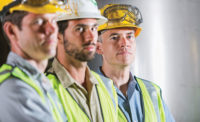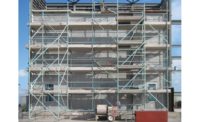Safety is very important in every aspect of life. Nobody wants to get hurt and end up in the emergency room or the morgue. We have safety belts in our cars. We have safety glasses to protect our eyes, ear plugs to protect our eyes, ear plugs to protect our hearing, boots for our feet, gloves for our hands and respirators for our lungs. Weight lifters have belts to help prevent hernias, hemorrhoids or even worse, a rear seal blow out. Firefighters have safety protection as well as our men in blue—a side-arm helps, as well. Everywhere you look there is some form of protection from personal injury. We have learned this the hard way. People got hurt and killed both working and playing. Hurt during sporting events and even leisure such as skiing.
Safety policies and equipment has continued to improve over the last few decades. Many years ago it wasn’t an issue. People got hurt. Some were killed. Others died slow and painful due to the long term effects of exposure to air born particles. This was the case with many of my older relatives that worked in the U.S. steel mills. I can remember as a teenager, working in a fabrication shop wearing tennis shoes without gloves, safety glasses or hearing protection. I didn’t know any better because everyone was dressed the same and no one had any protection. It was a normal work environment. I remember delivering some material to the steel mills. Once inside you could not see 20 feet because of all the particles and coal dust in the air. There were hundreds of men breathing that air, if that’s what you want to call it. I’m sure there was enough oxygen but there was plenty of other stuff that should not be inside your lungs. Let’s not even talk about the iron workers in the ’30s and ’40s connecting steel on high rise buildings.
In today’s commercial construction industry there are stringent requirements for safety and personal protection equipment. Most projects require a written safety policy. Some of them must be job specific. In some cases on very large developments, the owner or GC may require an in house certified safety director or manager that polices the project and practices. When Exxon constructed their new world headquarters north of Houston a subcontractor was required to have one safety director for every ten men he had on the project. Many contractors spend big money on safety equipment, me included. Commercially we have a handle on it because it’s enforced. We don’t want accidents or incidents for our men. After all, they’re the ones that make us money (most of the time).
Occupational Safety and Health Administration
OSHA was formed in April, 1971. This was nearly 16 months after the OSH Act was signed into the law by President Nixon. It was one of the good things of his presidency that he gave us. The other thing was that latex Nixon Halloween mask. Some of you won’t remember but those of us that do are laughing out loud. They were a big hit. OSHA is an agency under the U.S. Department of Labor. They are tasked with insuring a safe work environment. They also provide training and education if requested. Sometimes they can be a pain in the behind. Even the safest project in the world will have something they will find that needs improved and there’s nothing wrong with that, it’s their job. As I said, we all want a safe work place and OSHA is one of the enforcers. Are they?
Employer’s Responsibilities
All Employers have the responsibility to provide a safe workplace. By law, employers must provide their workers with a workplace that does not have serious hazards and must follow all OSHA safety and health standards. Employers must find and correct safety and health problems. OSHA further requires that employers must first try to eliminate or reduce hazards by making feasible changes in working conditions rather than relying on personal protective equipment such as masks, gloves, or earplugs. Switching to safer chemicals, enclosing processes to trap harmful fumes, or using ventilation systems to clean the air are examples of effective ways to eliminate or reduce risks. Keep in mind these are minimum requirements and exceeding them only improves safety for all.
We have determined that safety is the responsibility of all employers, according to the government laws and OSHA. They assess fines for violations. Sometimes they are pretty hefty fines. This is because of major budget cuts years ago by the feds. OSHA had to become more self-sufficient. The best way to generate revenue in the government is to raise taxes but that was not an option so the fines got bigger. Who do you think they focused on? For big money, they need to start writing fines to big companies because they have the money. A former employer told me many years ago he was given a huge fine for some scaffold violations. He pointed across the street to a retail project with a scaffold that violated everything in the book and asked, “What about that guy?” He was told, “That guy couldn’t afford the penalty but you can.”
Double Standards
Well, let’s get straight to the point for the way things are at ground zero. It’s very obvious that OSHA does their job in the commercial industry but why not in all work environments and by ALL employers. Why is there a blind eye in the residential sector or the retail sector? Why are framers allowed to build from a pump up jack? Why do stairs and balconies not have fall protection? Why can you go to a residential project and have open pits? Why do half of the deaths and injuries in construction occur in the residential sector and safety not be enforced by both the contractor and OSHA? This is the law. This is for saving lives and unnecessary injuries. Don’t tell OSHA, but think of the cash they are missing out on. It’s certainly not like the feds to let free money slip through their hands. Perhaps they are told to lay off residential because it would increase the cost of homes.
Ultimately safety is the responsibility of each individual. OSHA doesn’t need to be around to tell you that something is not being done in a safe manner. The equipment is available to protect you so why not use it. Be cautious of your work environment, of those working under you or above you. Think of what is at stake. Your life or their life, both are just as important. Safety doesn’t stop at the job site either. When working around the house, the ranch or doing a task for a friend, safety should be first on your mind. Wear your safety glasses and hearing protection when doing the lawn. Don’t over-reach on the ladder when hanging Christmas lights or other tasks. Falls are the worst. It happened to me a couple years ago. I was on the last 6-feet of lights and I fell six feet. I had broken ribs and a concussion. I was lucky. Many accidents you read about could have been avoided if done differently: safely.
Safety equipment and safe working conditions are not cheap but they’re cheaper than medical bills or a worker’s compensation claim, or even worse, a
funeral service.














